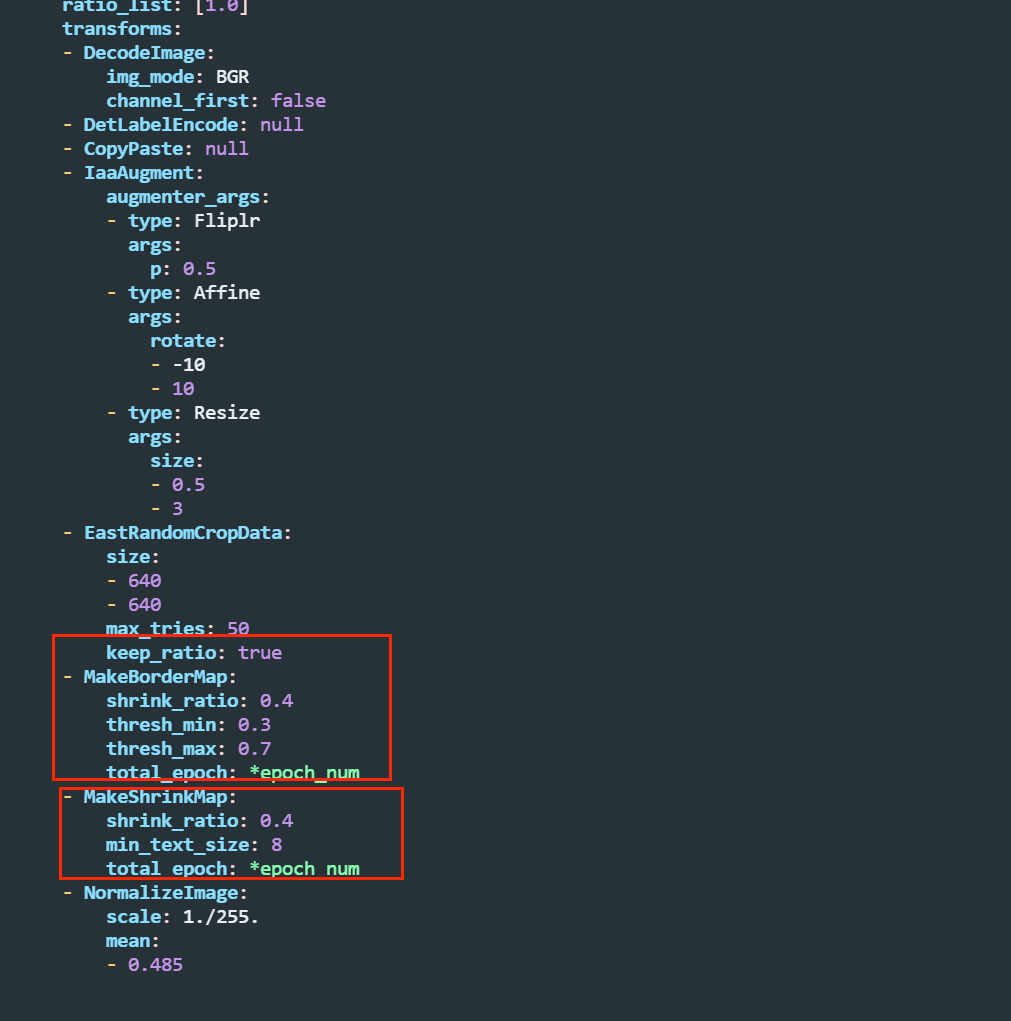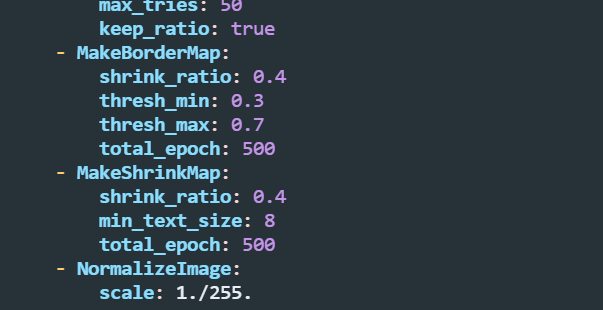/data/ocr/PaddleOCR-2.7.5/configs/det/ch_PP-OCRv4

造成的原因可能如下:

如果只需要跑较小的epoch,可以尝试将下面的total_epoch默认设置为500

目前猜测是epoch小了会影响下面代码执行
class MakeBorderMap(object):
def __init__(self,
shrink_ratio=0.4,
thresh_min=0.3,
thresh_max=0.7,
**kwargs):
self.shrink_ratio = shrink_ratio
self.thresh_min = thresh_min
self.thresh_max = thresh_max
if 'total_epoch' in kwargs and 'epoch' in kwargs and kwargs[
'epoch'] != "None":
self.shrink_ratio = self.shrink_ratio + 0.2 * kwargs[
'epoch'] / float(kwargs['total_epoch'])
def __call__(self, data):
img = data['image']
text_polys = data['polys']
ignore_tags = data['ignore_tags']
canvas = np.zeros(img.shape[:2], dtype=np.float32)
mask = np.zeros(img.shape[:2], dtype=np.float32)
for i in range(len(text_polys)):
if ignore_tags[i]:
continue
self.draw_border_map(text_polys[i], canvas, mask=mask)
canvas = canvas * (self.thresh_max - self.thresh_min) + self.thresh_min
data['threshold_map'] = canvas
data['threshold_mask'] = mask
return data
def draw_border_map(self, polygon, canvas, mask):
polygon = np.array(polygon)
assert polygon.ndim == 2
assert polygon.shape[1] == 2
polygon_shape = Polygon(polygon)
if polygon_shape.area <= 0:
return
distance = polygon_shape.area * (
1 - np.power(self.shrink_ratio, 2)) / polygon_shape.length
subject = [tuple(l) for l in polygon]
padding = pyclipper.PyclipperOffset()
padding.AddPath(subject, pyclipper.JT_ROUND, pyclipper.ET_CLOSEDPOLYGON)
padded_polygon = np.array(padding.Execute(distance)[0])
cv2.fillPoly(mask, [padded_polygon.astype(np.int32)], 1.0)
xmin = padded_polygon[:, 0].min()
xmax = padded_polygon[:, 0].max()
ymin = padded_polygon[:, 1].min()
ymax = padded_polygon[:, 1].max()
width = xmax - xmin + 1
height = ymax - ymin + 1
polygon[:, 0] = polygon[:, 0] - xmin
polygon[:, 1] = polygon[:, 1] - ymin
xs = np.broadcast_to(
np.linspace(
0, width - 1, num=width).reshape(1, width), (height, width))
ys = np.broadcast_to(
np.linspace(
0, height - 1, num=height).reshape(height, 1), (height, width))
distance_map = np.zeros(
(polygon.shape[0], height, width), dtype=np.float32)
for i in range(polygon.shape[0]):
j = (i + 1) % polygon.shape[0]
absolute_distance = self._distance(xs, ys, polygon[i], polygon[j])
distance_map[i] = np.clip(absolute_distance / distance, 0, 1)
distance_map = distance_map.min(axis=0)
xmin_valid = min(max(0, xmin), canvas.shape[1] - 1)
xmax_valid = min(max(0, xmax), canvas.shape[1] - 1)
ymin_valid = min(max(0, ymin), canvas.shape[0] - 1)
ymax_valid = min(max(0, ymax), canvas.shape[0] - 1)
canvas[ymin_valid:ymax_valid + 1, xmin_valid:xmax_valid + 1] = np.fmax(
1 - distance_map[ymin_valid - ymin:ymax_valid - ymax + height,
xmin_valid - xmin:xmax_valid - xmax + width],
canvas[ymin_valid:ymax_valid + 1, xmin_valid:xmax_valid + 1])
def _distance(self, xs, ys, point_1, point_2):
'''
compute the distance from point to a line
ys: coordinates in the first axis
xs: coordinates in the second axis
point_1, point_2: (x, y), the end of the line
'''
height, width = xs.shape[:2]
square_distance_1 = np.square(xs - point_1[0]) + np.square(ys - point_1[
1])
square_distance_2 = np.square(xs - point_2[0]) + np.square(ys - point_2[
1])
square_distance = np.square(point_1[0] - point_2[0]) + np.square(
point_1[1] - point_2[1])
cosin = (square_distance - square_distance_1 - square_distance_2) / (
2 * np.sqrt(square_distance_1 * square_distance_2))
square_sin = 1 - np.square(cosin)
square_sin = np.nan_to_num(square_sin)
result = np.sqrt(square_distance_1 * square_distance_2 * square_sin /
square_distance)
result[cosin <
0] = np.sqrt(np.fmin(square_distance_1, square_distance_2))[cosin
< 0]
# self.extend_line(point_1, point_2, result)
return result
def extend_line(self, point_1, point_2, result, shrink_ratio):
ex_point_1 = (int(
round(point_1[0] + (point_1[0] - point_2[0]) * (1 + shrink_ratio))),
int(
round(point_1[1] + (point_1[1] - point_2[1]) * (
1 + shrink_ratio))))
cv2.line(
result,
tuple(ex_point_1),
tuple(point_1),
4096.0,
1,
lineType=cv2.LINE_AA,
shift=0)
ex_point_2 = (int(
round(point_2[0] + (point_2[0] - point_1[0]) * (1 + shrink_ratio))),
int(
round(point_2[1] + (point_2[1] - point_1[1]) * (
1 + shrink_ratio))))
cv2.line(
result,
tuple(ex_point_2),
tuple(point_2),
4096.0,
1,
lineType=cv2.LINE_AA,
shift=0)
return ex_point_1, ex_point_2
class MakeShrinkMap(object):
r'''
Making binary mask from detection data with ICDAR format.
Typically following the process of class `MakeICDARData`.
'''
def __init__(self, min_text_size=8, shrink_ratio=0.4, **kwargs):
self.min_text_size = min_text_size
self.shrink_ratio = shrink_ratio
if 'total_epoch' in kwargs and 'epoch' in kwargs and kwargs[
'epoch'] != "None":
self.shrink_ratio = self.shrink_ratio + 0.2 * kwargs[
'epoch'] / float(kwargs['total_epoch'])
def __call__(self, data):
image = data['image']
text_polys = data['polys']
ignore_tags = data['ignore_tags']
h, w = image.shape[:2]
text_polys, ignore_tags = self.validate_polygons(text_polys,
ignore_tags, h, w)
gt = np.zeros((h, w), dtype=np.float32)
mask = np.ones((h, w), dtype=np.float32)
for i in range(len(text_polys)):
polygon = text_polys[i]
height = max(polygon[:, 1]) - min(polygon[:, 1])
width = max(polygon[:, 0]) - min(polygon[:, 0])
if ignore_tags[i] or min(height, width) < self.min_text_size:
cv2.fillPoly(mask,
polygon.astype(np.int32)[np.newaxis, :, :], 0)
ignore_tags[i] = True
else:
polygon_shape = Polygon(polygon)
subject = [tuple(l) for l in polygon]
padding = pyclipper.PyclipperOffset()
padding.AddPath(subject, pyclipper.JT_ROUND,
pyclipper.ET_CLOSEDPOLYGON)
shrinked = []
# Increase the shrink ratio every time we get multiple polygon returned back
possible_ratios = np.arange(self.shrink_ratio, 1,
self.shrink_ratio)
np.append(possible_ratios, 1)
# print(possible_ratios)
for ratio in possible_ratios:
# print(f"Change shrink ratio to {ratio}")
distance = polygon_shape.area * (
1 - np.power(ratio, 2)) / polygon_shape.length
shrinked = padding.Execute(-distance)
if len(shrinked) == 1:
break
if shrinked == []:
cv2.fillPoly(mask,
polygon.astype(np.int32)[np.newaxis, :, :], 0)
ignore_tags[i] = True
continue
for each_shirnk in shrinked:
shirnk = np.array(each_shirnk).reshape(-1, 2)
cv2.fillPoly(gt, [shirnk.astype(np.int32)], 1)
data['shrink_map'] = gt
data['shrink_mask'] = mask
return data
def validate_polygons(self, polygons, ignore_tags, h, w):
'''
polygons (numpy.array, required): of shape (num_instances, num_points, 2)
'''
if len(polygons) == 0:
return polygons, ignore_tags
assert len(polygons) == len(ignore_tags)
for polygon in polygons:
polygon[:, 0] = np.clip(polygon[:, 0], 0, w - 1)
polygon[:, 1] = np.clip(polygon[:, 1], 0, h - 1)
for i in range(len(polygons)):
area = self.polygon_area(polygons[i])
if abs(area) < 1:
ignore_tags[i] = True
if area > 0:
polygons[i] = polygons[i][::-1, :]
return polygons, ignore_tags
def polygon_area(self, polygon):
"""
compute polygon area
"""
area = 0
q = polygon[-1]
for p in polygon:
area += p[0] * q[1] - p[1] * q[0]
q = p
return area / 2.0





















 3242
3242

 被折叠的 条评论
为什么被折叠?
被折叠的 条评论
为什么被折叠?








